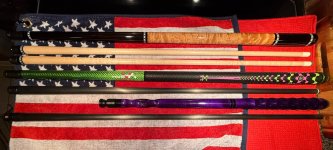Pool Ball Collecting.
- By Mulambo
- Main Forum
- 2885 Replies
Is it unviable for manufacturers like Aramith to make small runs of older sets again?
There is obviously a market for balls like the Roman numbers, Card Ball/Poker Pool balls with suits on them, and so on. I mean if they see, that these old sets sell for a big amount second hand, won‘t they think about making a re-run and cash in on the hype? I have no clue how the balls are exactly made, but if they produced them once, they still should have moulds/templates or whatever is used to produce said ball sets again.
Just curious here…
There is obviously a market for balls like the Roman numbers, Card Ball/Poker Pool balls with suits on them, and so on. I mean if they see, that these old sets sell for a big amount second hand, won‘t they think about making a re-run and cash in on the hype? I have no clue how the balls are exactly made, but if they produced them once, they still should have moulds/templates or whatever is used to produce said ball sets again.
Just curious here…


